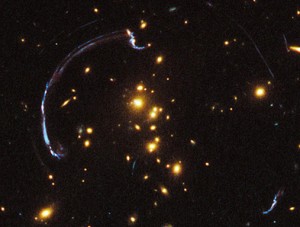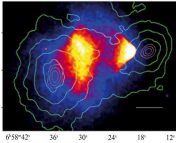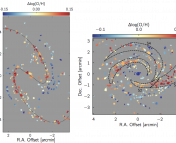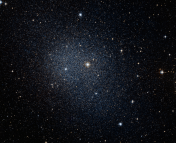- Paper title: The Metallicity Evolution of Star-Forming Galaxies from Redshift 0 to 3: Combining Magnitude Limited Survey with Gravitational Lensing
- Authors: T.-T. Yuan, L. J. Kewley, J. Richard
- 1st Author’s Institution: University of Hawaii
The very first stars in the universe formed out of primordial gas which was created in the big bang, which consisted mostly of hydrogen and helium with trace amounts of lithium. All the heavy elements that we see today (such as carbon, oxygen, and everything else necessary for life as we know it) then had to be formed in fusion reaction at the center of stars, then released into the universe at large through stellar winds or supernovae in a process known as metal enrichment. To an astronomer, “metals” are anything on the periodic table besides hydrogen and helium. Ian’s astrobite gives a good overview of this process.
This means that a galaxy’s metallicity is sensitive to its history of star formation, but also to the rate at which it sucks up or expels gas into the intergalactic medium. Studying metal abundance is a good way to get a handle on the processes that shape galaxy formation. Past results have shown that a galaxy’s metal abundance is directly related to its total mass (the mass-metallicity relation) with more massive galaxies having greater concentrations of metals.

An example of gravitational lensing is seen in this Hubble image of galaxy cluster RCS2 032727-132623. The blue arc is a galaxy located behind the central, orange-colored cluster, its image distorted by the extreme mass of the cluster.
However, those studies have mostly probed out to redshift 1. Redshift, in this context, results from the expansion of space which causes farther galaxies to move away from us at a faster rate and thus appearing more redshifted than nearby galaxies. Redshift then indicates distance, but because light takes time to travel that distance, a galaxy at a higher redshift also appears to us as it was some time in the past. The study described by this paper was designed to cover galaxies out to redshift 3 (only 2 billion years after the big bang) by making use of gravitational lenses (Alice’s astrobite gives a good explanation of this phenomenon.)
In short, because mass can curve space and therefore bend the path that light takes, certain configurations of high mass can act like lenses, distorting and magnifying the view of distant objects. Gravitational lenses allow us to see out to far distances (higher redshifts) which would otherwise require enormous amounts of telescope time.
The authors of the study used the galaxy cluster Abell 1689, which is known to act as a gravitational lens for about thirty distant galaxies. Taking spectra of these galaxies allowed them to determine metal abundances: when metal atoms in the galaxy’s gas bump into other atoms in the gas, they’re excited into a higher energy state (what’s known as collisional excitation). When they fall back to their lowest energy state they emit a photon with a precise amount of energy, which shows up on a spectrum as an emission line. The intensity of these lines, then, can tell us about the abundances of metals in these galaxies.
Results
Since galaxies have been enriched with metals over time, we would expect the galaxies at higher redshift to have less metal abundance than galaxies in the nearby universe. Remember, a higher redshift means a farther distance and younger galaxies, as it takes time for light to cross the expanse of space.
This is indeed what the authors find. The higher-redshift galaxies are younger and haven’t had as much time to form heavier elements, and they’re also still sucking in metal-poor primordial gases. More interesting is how the metal enrichment rate has changed over time: the increase in metallicity has dramatically sped up in recent times (from redshift 0.8 to 0) compared to the earlier universe (redshift greater than 2) when it stayed relatively constant.
There have been several attempts to model galaxy evolution with computer simulations. The authors compare their findings with one of the most up-to-date models available and find that the model predicts higher metallicities in high-mass galaxies than were observed.
All of this indicates that there must be other factors at work in galaxy evolution than what we’ve already accounted for in our models. It’s tests like these, which compare observations to models, that ultimately advance our science.






Trackbacks/Pingbacks